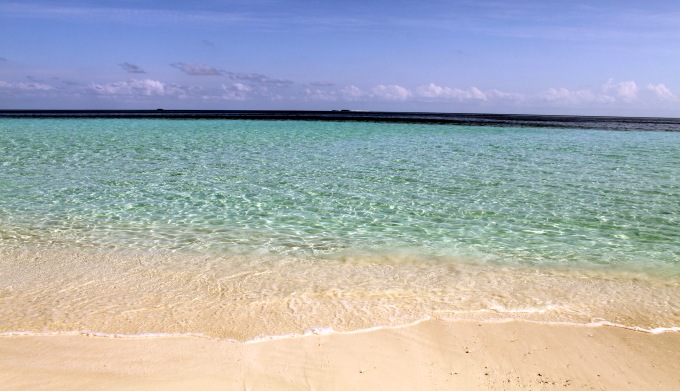New research shows that global warming is stripping the Indian Ocean of its microscopic plants, or phytoplankton; this could impact food security in the region and the global fisheries market

Indian Ocean has lost 20% of its marine phytoplankton in the last six decades because of global warming. (Image by flowcomm)
The Indian Ocean has lost up to a fifth of its microscopic plants in the last six decades due to global warming. This could turn one of the most biologically productive regions of the world into “an ecological desert” and impact future food security, new research shows.
The decline in marine microscopic plants or ‘phytoplankton’ — including single-celled algae and marine bacteria — due to rapid warming in the Indian Ocean has been reported by a team comprising scientists from the Indian Institute of Tropical Meteorology (IITM), Pune, National Institute of Oceanography (NIO), Goa and Indian National Centre for Ocean Information Services (INCOIS), Hyderabad as well as those from the University of Maryland, University of Sorbonne and University of Cape Town.
The findings, published in the Geophysical Research Letters (GRL) in January 2016, contradict previous studies which indicate that global warming could be beneficial to phytoplankton in the Indian Ocean, and that they may increase.
The Indian Ocean has the largest amount of marine plants among tropical oceans; it also shows the largest ocean surface warming, the scientists say. “Ocean warming in the Indian Ocean increased up to 1.2 degrees Celsius during the past century, compared to a global ocean surface warming of up to 0.8 degrees Celsius during the same time period,” IITM scientist Roxy Mathew Koll — one of the authors of the paper — wrote in AGU.Blogosphere.
Besides, their research also shows that warming is leading to more ‘stratification’, or formation of water layers with different temperatures, salinity and oxygen levels, which is preventing mixing of water and, therefore, mixing of nutrients needed by the marine plankton.
“The reason that the Indian Ocean did not show these results before is due to the fact that the region is exposed to strong monsoon winds, which makes the dynamics complex,” Koll told indiaclimatedialogue.net.
Koll’s team used data from satellite sensors and historical simulations from climate models. While the historical simulations indicated up to 20% decrease in marine phytoplankton during the past six decades, the satellite data showed up to 30% decline in the western Indian Ocean in the last 16 years.
“Considering the fact that the warming in the Indian Ocean is the largest and rapid among the tropical oceans, and that climate models project further warming in the future, the significance of the new findings is large,” Koll said. “Such a decline in the marine phytoplankton may cascade through the food chain, turning this biologically productive region into an ecological desert. This can potentially impact the food security in the Indian Ocean rim countries and also the global fisheries market, for example, Japan, USA and several European Union countries.”
Available data shows that tuna catch rates have declined by 50-90% during the past five decades, mainly due to increased industrial fishing, and that the reduced phytoplankton may serve as an additional stress factor. “Exploiting a resource that may be in decline may tip it over a point of no return,” the report cautions.
Marine phytoplankton sustain aquatic food webs, and drive the marine ecosystem and fish catches, the scientists say. They also influence the climate cycle and geochemical cycles by absorbing sun’s radiation and modulate temperature changes over the upper ocean regions.
Among the tropical oceans, the Indian Ocean has the maximum phytoplankton during summer as strong monsoonal winds cause the waters to swell, bringing the tiny plants and nutrients to the surface and increasing their productivity.
According to Food and Agriculture Organisation statistics, the Indian Ocean, with 20% of the world’s tuna catch, especially the economically valuable big eye tuna, is the second largest supplier to the world’s tuna market.
The Indian Ocean appears to be a great challenge not only for humans because the monsoon is decreasing as the Indian Ocean is warming, but also for living marine resources because the bottom of their food chain is weakening, at least in the western Arabian Sea, says Ravi Mutugudde, from the University of Maryland.
“The Indian Ocean must thus be monitored closely for clues about the response of the marine ecosystems in the rest of the world oceans,” he says.
The Indian Ocean must also be monitored closely “to see if it is acting as an early indicator of physical-biological interactions in a warming world”, the report concludes.
Previous findings
The latest findings completely overturn previous findings on the impact of global warming on biological productivity in the Arabian Sea and Indian Ocean.
NIO scientist S Prasanna Kumar, who is part of the latest study, had in 2011 reported in the journal Marine Environmental Research that increased occurrence of cyclones in a warming environment leads to more frequent strong winds, driving the sub-surface nutrients in an upward direction and bringing them to the ocean surface. This, in turn, leads to more photosynthesis (the process by which plants make food using carbon dioxide in the presence of sunlight) at the ocean surface, and more plankton blooms.
In 2010, Prasanna Kumar’s’s team at NIO reported in Climate Change and Aquatic Systems results from their studies on satellite data on concentrations of the green plant pigment chlorophyll in the Arabian Sea from 1998 to 2006. They found an increasing trend, with a substantial rise in September, followed by October, and a smaller increase in winter months.
